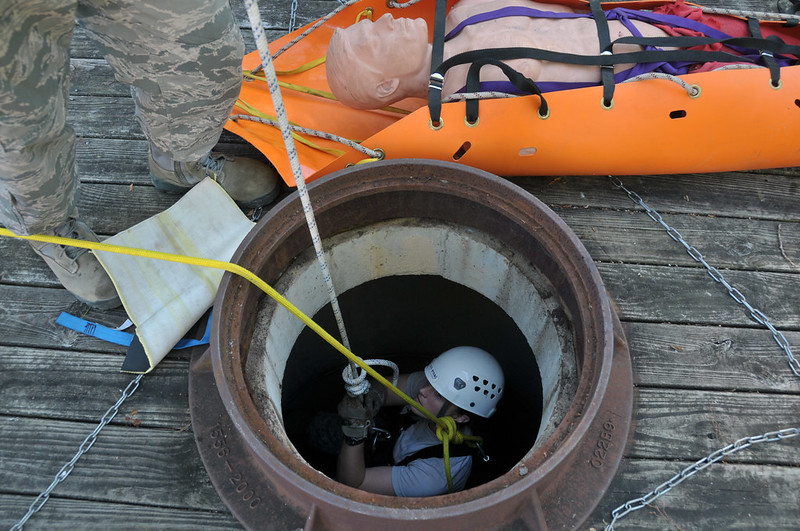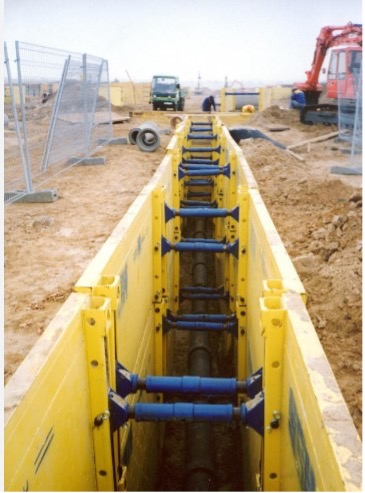Competency F1: Test and Service Sanitary and Storm Drainage Systems
Learning Task 5
Describe Troubleshooting Procedure for Manholes, Catch Basins, and Piping for Sewers
The goal of troubleshooting is to verify the problem or problems in a system and then repair or replace as needed. When attempting to determine the faults in a manhole, catch basin, or the piping for sewers, it is important that the work is done safely following all Worksafe BC guidelines. Also, using the proper equipment will help identify problems as quickly as possible.
Verify Reported Problem
When responding to a call for service, personnel must gather as much information as they can about the issues. Some common problems with manholes and catch basins are that captured debris can take a long time to dry. During summer months, the moist debris creates an environment that is ideal for insects to breed and cause clogs. They may need to be exterminated. Also, as water pools around catch basins, they have the potential to cause a sinkhole. They may need to be dug out and back filled. A sinkhole could also break the sewer piping connected to the manhole or catch basin. If a sinkhole is the cause of the problem, the sewer piping should be thoroughly checked for cracks or breaks.
Safe Work Practices
Confined Space
Confined Spaces WorkSafeBC’s OSH Regulation: Part 9 includes this definition of a confined space: “confined space”, except as otherwise determined by the Board, means an area, other than an underground working, that:
- is enclosed or partially enclosed
- is not designed or intended for continuous human occupancy
- has limited or restricted means for entry or exit that may complicate the provision of first aid, evacuation, rescue, or other emergency response service, and
- is large enough and so configured that a worker could enter to perform assigned work.
A space may also be a permit-required confined space if it has a hazardous atmosphere, the potential for engulfment or suffocation, a layout that might trap a worker through converging walls or a sloped floor, or any other serious safety or health hazard. The current Confined Spaces standard is a component of provincial Worker Compensation Board (WCB) legislation.

The following are examples of some of those requirements for safe entry of confined spaces.
- Preparation: Before workers can enter a confined space, employers must provide pre-entry planning. This includes:
- Having a competent person evaluate the work site for the presence of confined spaces, including permit-required confined spaces.
- Once the space is classified as a permit-required confined space, identifying the means of entry and exit, proper ventilation methods, and elimination or control of all potential hazards in the space.
- Ensuring that the air in a confined space is tested before workers enter, and at specified intervals thereafter, for oxygen levels, flammable and toxic substances, and stratified atmospheres.
- If a permit is required for the space, removing, or controlling hazards in the space and determining rescue procedures and necessary equipment.
If the air in a space is not safe for workers, ventilating or using whatever controls or protections are necessary so that employees can safely work in the space. The employer must implement additional specific requirements in the OHS legislation regarding hazard assessment. Workers are responsible for carrying out their work in a manner that does not endanger them or their fellow workers. Workers must cooperate with their employer by following safe work procedures and using the equipment provided to complete the job safely. 12 Industry Training Authority BC Confined Spaces Air Quality Hazards Air quality hazards are the most immediate of the concerns regarding confined space entry. Those concerns can originate from things such as:
- Insufficient amount of oxygen for the worker to breathe
- Toxic gases that could make the worker ill or cause the worker to lose consciousness
- The presence of asphyxiants. Simple asphyxiants are gases which can displace oxygen in the air. Low oxygen levels (19.5 percent or less) can cause symptoms such as rapid breathing, rapid heart rate, clumsiness, emotional upset, and fatigue. As less oxygen becomes available, nausea and vomiting, collapse, convulsions, coma and death can occur. Unconsciousness or death could result within minutes following exposure to a simple asphyxiant. Asphyxiants include argon, nitrogen, or carbon monoxide. It is important to note that wherever there is ferrous piping present, the rusting process can use up the available oxygen in a confined space, contributing to the likelihood of asphyxiation.
Shoring
Since manholes, catch basins, and piping for sewers are installed in slab or underground, it is often necessary to do some digging to access the areas to be inspected for faults. If a trench is to be made that is more than 4’ deep, Worksafe BC requires that shoring be used to ensure the safety of any worker entering the trench. The sides of a trench must be supported by sheet piling or shoring that meet Worksafe BC minimum standards or sloped to an angle no more than 3’ horizontal to every 4 vertical feet. Approved trench boxes (Figure 20) can also be used as an alternate to sloping.

Inspection
Manholes covers can be lifted off and, using a light, an inspection can be performed.
To inspect a catch basin first sweep any leaves, garbage, and debris away from the grate to ensure it does not block the flow of stormwater. The grate can then be lifted and the inside inspected.
Inspection for both manholes and catch basins can be performed every three months to check sediment build up, or floating oil levels. This will help determine rate of accumulation so a maintenance schedule can be established. If either component continues to be more than one third full in an annual inspection, then it should be cleaned more frequently. If a catch basin is collecting things like woody debris, then it should be cleaned on a more regular schedule.
 Now complete Self-Test 5 and check your answers.
Now complete Self-Test 5 and check your answers.
Self-Test 5
Self-Test 5
Media Attributions
- Figure 19. “Confined space“ by New York National Guard is licensed under a CC BY-ND 2.0 licence.
- Figure 20. “Shoring“ by Sbhrus is licensed under a CC BY-SA 3.0 licence.

